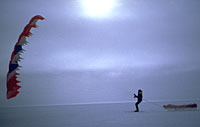|


|

|
When the kite became a parafoil.
It is virtually certain that kites first appeared more than two
thousand years ago in China, but this has never been proved with
any certainty. China is the country where the basic materials can
be found for building kites: bamboo for the frame, and silk for
the sail and bridles.
Kites were initially considered to be a magic link with heaven,
used for finding out about the fate and future, as well as for
celebrating births, happy events and victories. There are several
legends in Chinese folklore which see the kite being used for
many purposes, particularly military ones. The story goes that
general Han Hsin used a kite to calculate the distance
between his troops and a fortress that he was besieging. After
measuring the line, he had an underground tunnel built and invaded
the enemy through it, using the tactic of surprise. During the
Han dynasty, another legend says that the Chinese used kites to
frighten the enemy. They flew kites fitted with bamboo whistles
over the enemy positions during the night; hearing strange noises
and thinking that they were voices predicting defeat, the enemy
is said to have fled, terrified. The story is also told of the
famous Japanese bandit, Kakinkoki Kinsuke, who is said
to have built an enormous kite to carry him over the castle at
Nagoya to steal the golden fins of the dolphins.
Today in China and in other oriental countries, kites are used
to evoke tales of folklore, with images painted on the sails recalling
great battles and great legendary deeds involving heroes and the
gods. From China, kites spread throughout Asia, arriving in Europe
some time later. During modern times, they have also been used
in the United States.
Although the kite is thousands of years old, kite traction
is more recent. Some centuries old, to judge from old Oriental
paintings the writings of Marco Polo, which mention canoes from
Samoa being pulled by kites.
Kites were probably used as tractors in Europe and America in
the 18th and 19th centuries. In England, William Peacock
invented a coach pulled by a kite in 1826. The kite had several
lines and enabled the driver to go upwind and downwind. Six years
later, Ben Franklin created kites which were capable of
helping shipwrecked sailors to stay afloat and to guide themselves
at sea using another invention, human fins. In 1903, Samuel
Cody demonstrated the stability of his kite by crossing the
Channel aboard a boat pulled by it. The era of the Kite Brigade
of the "Mounted Kites" during the 1914-18 war showed the
attractions of the kite as a powerful method of traction. Between
the wars, the Spa festival was the main meeting place for the
world of traction kite-flyers. Enthusiasts from the four corners
of the world came to Spa to take part in a series of manned flights.
From 1980 onwards, Dan Eiseman crossed all of the Great
Lakes in America aboard an inflatable boat pulled by kites.
The first adventurer of the modern age to use a parafoil on
a polar expedition was the German, Udo Krieger, in 1998
during the expedition to commemorate the centenary of the first
crossing of Greenland by Nansen. He used a 10 sq.m. parafoil,
the Parawing, designed by the German, Wolf Beringer The same piece
of apparatus - rather rudimentary when compared to modern parafoils
- was used by Reinhold Messner and Alved Fuchs during their Antarctic
crossing in 1989-90.
In 1996-97, the Norwegian, Børge Ousland travelled
1600 km using a parafoil (he had two of them), during his successful
first entirely solo crossing of Antarctica over a distance of
2845 km.
 Dixie
Dansercoer and Alain Hubert used this same type of parafoil, the
parawing, with a variety of sail areas during their first crossing
of Greenland in 1995. It was during this expedition that the two
Belgians came to realise that for their Antarctic adventure, they
would have to find a system of parafoil which gave greater performance,
but was also lighter (see
section on parafoils). Dixie
Dansercoer and Alain Hubert used this same type of parafoil, the
parawing, with a variety of sail areas during their first crossing
of Greenland in 1995. It was during this expedition that the two
Belgians came to realise that for their Antarctic adventure, they
would have to find a system of parafoil which gave greater performance,
but was also lighter (see
section on parafoils).
|

